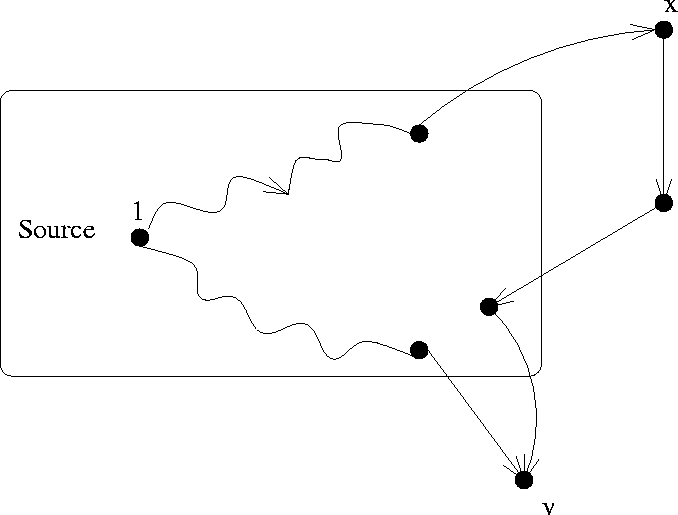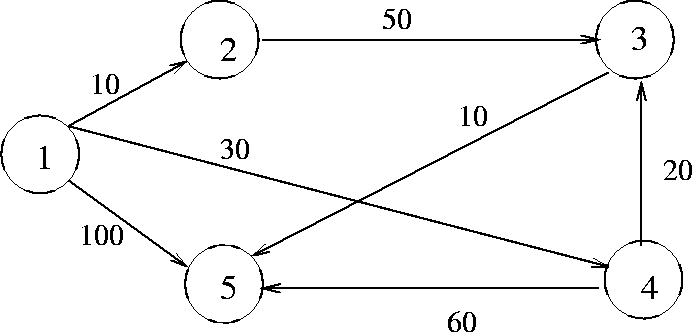


Next:7.2.2
Dynamic Programming AlgorithmUp:7.2
Shortest Paths ProblemPrevious:7.2
Shortest Paths Problem
7.2.1 Single Source Shortest
Paths Problem: Dijkstra's Algorithm
-
REF.
-
E.W. Dijkstra. A note on two problems in connection with graphs.
Numerische
Mathematik, Volume 1, pp. 269-271, 1959.
-
Greedy algorithm
-
It works by maintaining a set S of ``special'' vertices whose shortest
distance from the source is already known. At each step, a ``non-special''
vertex is absorbed into S.
-
The absorption of an element of V - S into S is done
by a greedy strategy.
-
The following provides the steps of the algorithm.
Let
| V |
= |
{1, 2,..., n} and source = 1 |
(7.1) |
| C[i, j] |
= |
 |
|
{
S= { 1 };
for (i = 2; i < n; i++)
D[i] = C[1,i];
for (i=1; i < = n-1; i++)
{
choose a vertex w  V-S such that D[w] is a minimum;
V-S such that D[w] is a minimum;
S = S  {w };
{w };
for each vertex v  V-S
V-S
D[v] = min (D[v], D[w] + C[w, v])
}
}
-
The above algorithm gives the costs of the shortest paths from source vertex
to every other vertex.
-
The actual shortest paths can also be constructed by modifying the above
algorithm.
Theorem: Dijkstra's algorithm finds the shortest paths from a single
source to all other nodes of a weighted digraph with positive weights.
Proof: Let V = 1, 2, ..., n and 1 be the source vertex. We use
mathematical induction to show that
-
(a)
-
If a node i (
 1)
1)  S,
then D[i] gives the length of the shortest path from the source to i.
S,
then D[i] gives the length of the shortest path from the source to i.
-
(b)
-
if a node i
 S,
then D[i] gives the length of the shortest special path from the source
to i.
S,
then D[i] gives the length of the shortest special path from the source
to i.
Basis: Initially S = 1 and hence (a) is vacuously true. For i S,
the only special path from the source is the direct edge if present from
source to i and D is initialized accordingly. Hence (b) is also true.
S,
the only special path from the source is the direct edge if present from
source to i and D is initialized accordingly. Hence (b) is also true.
Induction for condition (a)
-
The induction hypothesis is that both (a) and (b) hold just before we add
a new vertex v to S.
-
For every node already in S before adding v, nothing changes, so condition
(a) is still true.
-
We have to only show (a) for v which is just added to S.
Figure 7.4: The shortest path to v cannot visit x
 |
-
Before adding it to S, we must check that D[v] gives the length of the
shortest path from source to v. By the induction hypothesis, D[v] certainly
gives the length of the shortest special path. We therefore have to verify
that the shortest path from the source to v does not pass through any nodes
that do not belong to S.
-
Suppose to the contrary. That is, suppose that when we follow the shortest
path from source to v, we encounter nodes not belonging to S. Let x be
the first such node encountered (see Figure 7.4
). The initial segment of the path from source to x is a special path and
by part (b) of the induction hypothesis, the length of this path is D[x].
Since edge weights are no-negative, the total distance to v via x is greater
than or equal to D[x]. However since the algorithm has chosen v ahead of
x, D[x]
 D[v].
Thus the path via x cannot be shorter than the shortest special path leading
to v.
D[v].
Thus the path via x cannot be shorter than the shortest special path leading
to v.
Induction step for condition (b): Let 
 v
and
v
and 
 S.
When v is added to S, these are two possibilities for the shortest special
path from source to w:
S.
When v is added to S, these are two possibilities for the shortest special
path from source to w:
-
1.
-
It remains as before
-
2.
-
It now passes through v ( and possibly other nodes in S)
In the first case, there is nothing to prove. In the second case, let y
be the last node of S visited before arriving at w. The length of such
a path is D[y] + C[y,w].
-
At first glance, to compute the new value of d[w], it looks as if we should
compare the old value of D[w] with D[y] + C[y,w] for every y
 S (including v)
S (including v)
-
This comparison was however made for all y
 S except v, when y was added to S in the algorithm. Thus the new
value of D[w] can be computed simply by comparing the old value with D[v]
+ C[v,w]. This the algorithm does.
S except v, when y was added to S in the algorithm. Thus the new
value of D[w] can be computed simply by comparing the old value with D[v]
+ C[v,w]. This the algorithm does.
When the algorithm stops, all the nodes but one are in S and it is clear
that the vector D[1], D[2], ..., D[n]) contains the lengths of the shortest
paths from source to respective vertices.
Example: Consider the digraph in Figure 7.5.
Figure 7.5: A digraph example for Dijkstra's algorithm
 |
Initially:
S
= {1} D[2] = 10 D[3] =  D[4] = 30 D[5] = 100
D[4] = 30 D[5] = 100
Iteration 1
Select w = 2, so that S = {1, 2}
| D[3] |
= |
min( ,
D[2]
+ C[2, 3]) = 60 ,
D[2]
+ C[2, 3]) = 60 |
(7.2) |
| D[4] |
= |
min(30, D[2] + C[2, 4]) = 30 |
(7.3) |
| D[5] |
= |
min(100, D[2] + C[2, 5]) = 100 |
|
Iteration 2
Select w = 4, so that S = {1,
2, 4}
| D[3] |
= |
min(60, D[4] + C[4, 3]) = 50 |
(7.4) |
| D[5] |
= |
min(100, D[4] + C[4, 5]) = 90 |
|
Iteration 3
Select w = 3, so that S =
{1, 2, 4, 3}
| D[5] |
= |
min(90, D[3] + C[3, 5]) = 60 |
|
Iteration 4
Select w = 5, so that S
= {1, 2, 4, 3, 5}
| D[2] |
= |
10 |
(7.5) |
| D[3] |
= |
50 |
(7.6) |
| D[4] |
= |
30 |
(7.7) |
| D[5] |
= |
60 |
|
Complexity of Dijkstra's Algorithm
With adjacency matrix representation, the running time is O(n2) By using
an adjacency list representation and a partially ordered tree data structure
for organizing the set V - S, the complexity can be shown to be
O(elog n)
where e is the number of edges and n is the number of vertices in the digraph.



Next:7.2.2
Dynamic Programming AlgorithmUp:7.2
Shortest Paths ProblemPrevious:7.2
Shortest Paths Problem
eEL,CSA_Dept,IISc,Bangalore
![]() V-S such that D[w] is a minimum;
V-S such that D[w] is a minimum;
![]() {w };
{w };
![]() V-S
V-S


![]() D[4] = 30 D[5] = 100
D[4] = 30 D[5] = 100